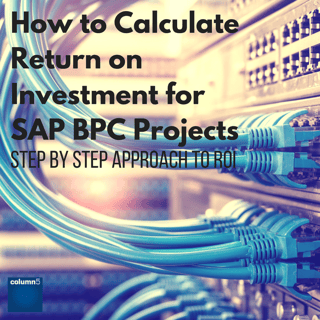We know that EPM (and specifically SAP BPC) implementations have the potential to be very profitable, more so than other IT projects like ERP implementations. But how do you prove that?
than other IT projects like ERP implementations. But how do you prove that?
This blog takes a step by step approach to building a solid business case for a SAP BPC implementation. There are many intangible benefits to an EPM project which are difficult to put a value to, but we can set out all the costs and calculate a large part of the benefits. Even without adding in the intangible benefits, such as improved data quality, higher management efficiency and faster decision making, BPC projects can still be very profitable projects, so let’s go through the business case elements step by step.
Direct Costs
Software licensing costs – SAP BPC is generally licensed per user.
Software maintenance costs – Updates, patches, and support should be included here. Typically a major upgrade to the next version of the software would be carried out every three years or so and would be a separate EPM project. SAP BPC projects have the additional advantage that no software costs are incurred for major upgrades, and they are included in the normal maintenance costs.
Hardware costs – Server capacity can be outsourced or in the cloud, in which case there is a monthly cost. Alternatively, if in-house servers are used, the purchase cost should be depreciated over the three years of the project life.
Server software costs – Server and database software costs should be included. Either the server database software will need to be purchased or additional user licences obtained if the software is already installed. For the SAP BPC MS version, this means having MS SQL Server Enterprise Edition, and for SAP BPC NetWeaver, the server software will be the SAP NetWeaver software and the underlying database may be HANA or a traditional database.
Indirect Costs
Data warehousing costs – Where a data warehouse is maintained by the company and used as a source for the EPM tool, additional work will need to be carried out to prepare the data and output files for upload.
Integration costs - Where data is transferred directly from the ERP system to the EPM tool, additional work will also need to be carried out to prepare the data and data-connectors for transfer. In the case of SAP BPC 10.1 NW these costs are negligible because the solutions sit together with the underlying ECC and BW installations on the same server and read directly from the same data objects, so no data connectors are needed and, as the data is shared, no data transformation is needed.
Personnel costs – EPM administrators, who are generally people with both finance and IT experience, are needed to maintain the master data, build reports, and fix breaks. This profile can be difficult to find and expensive. Column5 offers a flexible Managed Services package which provides cover from experienced consultants to carry out these tasks, which may be more cost effective than employing an extensive in-house admin team.
 Deployment and configuration costs – These are a large part of the EPM project set-up costs, but they are a one-time cost for initial set-up. They will vary greatly depending on the complexity of the data transformations that may need to be carried out in SAP BPC (allocations, currencies, driver-based forecasting, consolidations), the number and complexity of reports and input schedules, or if implementation of Business Process Flows is needed. Savings can be made here if work can be done in-house in collaboration with your EPM services partner.
Deployment and configuration costs – These are a large part of the EPM project set-up costs, but they are a one-time cost for initial set-up. They will vary greatly depending on the complexity of the data transformations that may need to be carried out in SAP BPC (allocations, currencies, driver-based forecasting, consolidations), the number and complexity of reports and input schedules, or if implementation of Business Process Flows is needed. Savings can be made here if work can be done in-house in collaboration with your EPM services partner.
Training costs – Training should generally count for 10% of the overall project costs. Where this money is not spent, user adoption is generally low and the whole value of the project is severely compromised. Classroom training can be expensive, disruptive to day-to-day tasks, and it is also a one-shot approach; once it has been given it is easily forgotten. On-the-job knowledge transfer in collaboration with your EPM services partner is another, more useful, approach. eLearning, where users can study at their own convenience over months and come back to the web-based courses time after time to check their knowledge is one of the best training tools available. Column5 has an extensive programme of e-learning for SAP BPC available at its EPM Academy website.
Direct Benefits
 Increased finance efficiency (time saving on Finance tasks) – This is one of the key benefits of an EPM implementation. Time spent manipulating very large Excel spreadsheets, investigating discrepancies, maintaining various versions, and checking formulas has been described as ‘Excel hell’. As much as half of the time spent on financial closes, management reporting, budgeting, and forecasting done with Excel can be saved on an initial EPM implementation. This time can be allocated to more productive tasks, or in some cases companies take the option to reduce headcount. The savings are easy to calculate in the case of headcount reduction, but it should also be possible to put a number on the time saved and allocated to other tasks.
Increased finance efficiency (time saving on Finance tasks) – This is one of the key benefits of an EPM implementation. Time spent manipulating very large Excel spreadsheets, investigating discrepancies, maintaining various versions, and checking formulas has been described as ‘Excel hell’. As much as half of the time spent on financial closes, management reporting, budgeting, and forecasting done with Excel can be saved on an initial EPM implementation. This time can be allocated to more productive tasks, or in some cases companies take the option to reduce headcount. The savings are easy to calculate in the case of headcount reduction, but it should also be possible to put a number on the time saved and allocated to other tasks.
Time savings on IT tasks – Due to the very structured and centralised approach that an EPM implementation obliges an organisation to adopt, some savings can be seen in IT tasks that are no longer necessary such as maintenance of the numerous personalised custom built VBA applications that are typical of many companies.
Indirect Benefits
Clearer view of the company’s financial data – An EPM implementation will give the finance managers a much better vision of the status of their financial indicators. This means that they are able to react faster to recognise revenue, manage the pipeline of prospects more efficiently, and have a clearer view of consolidated data.
Clearer view of the company’s operational data – Although EPM is traditionally used in finance departments, it can also be used to aggregate and analyse operational data. All the benefits of clearer vision and quicker turnaround are also available in this case.
More achievable plans – the exercise to produce an enterprise wide plan for a given period is typically an arduous undertaking. By embracing an Integrated Business Planning (IBP) design, data from strategic, operational and financial plans can be aligned, thus revealing gaps and risks to the achievement of the plan. By exposing these gaps, decisions can be made to achieve the plans’ objectives more directly.
One single view – Having a single version of the truth is very positive in many intangible ways, but one way it can bring concrete results is in consolidation of newly acquired acquisitions. The instant vision of the new company as seen through the group chart of accounts is a very tangible benefit.
Optimization of receivables and payables – Cashflow is improved by timely collection and payment made more efficient by EPM
Optimization of inventory & cash – with more timely visibility into demand, production plans can be honed to be more responsive, thus limiting excess inventory. This efficiency creates an opportunity to deploy cash more efficiently, minimizing financing costs or maximizing interest earning potential.
Related Content: Technology vs. Process?
Intangible Costs and Benefits
Faster decision making – EPM automates many tasks that were manual before, making them much quicker. One example would be the ability make better project-financing decisions because you have the information you need to make that decision to hand, and that will lead to quicker profitability.
Improving data quality – Confidence in the data quality is very important in any organization. Good data quality improves all aspects of the finance department’s tasks.
ROI Calculation
To calculate the Return on Investment, simply take the sum of your project costs and the sum of your project benefits, convert them to the present value at the end of the three year life of the project, divide one by the other, take away 1, and multiply by 100 to give the ROI percentage:
ROI = ((PV of Benefits / PV of Costs) -1) x 100
One other important factor
One key point which comes up time and again when researching ROI of EPM projects is that “the right professional services partner is critical to EPM deployment success”. That means choosing Column5 as your EPM partner so that you can benefit from the experience gained over 250 full scale SAP EPM implementations globally since 2005.
To learn more from Column5 experts, check out the EPM Summit!
Related Content:
Blog Post: Penny Wise and Pound Foolish: Why Your Focus on "Cheap" is Killing Your Profits
Blog Post: Evaluating EPM? Where to Start Without Hiring a Consultant!
Blog Post: EPM Value Is Exclusively The Client's Definition
Blog Post: The Easy Way to Increase EPM ROI - Part 1
 Author Bio:
Author Bio:
Richard Hynes has been with Column5 Consulting as a Senior Consultant since 2014 and is one of our most popular bloggers, and is also a published author in print with technical books on Microsoft Excel and Database Programming with .NET. He is a trilingual BI professional with a double competency in Finance and IT. Hynes works on the UK team and works with various clients in EMEA.
Richard Hynes, Senior Consultant, UK Team











